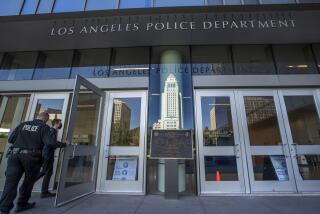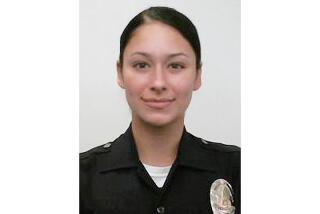An honor overdue
At a movie theater that no longer exists, on a street since renamed, several gun-toting bandits robbed a teenage cashier of $90. Although the crime was nothing spectacular, the outcome tragically was.
It was Feb. 4, 1946, shortly after 9 p.m., when LAPD Officer Walter Kesterson’s car radio squawked with news of the stickup. He and his partner, dressed in plain clothes, were working a crime suppression detail around the Los Angeles Coliseum, near the heist. As they cruised the neighborhood, they saw two men matching the suspects’ descriptions at the corner of 43rd Place and Avalon Boulevard. Suspicious, they quickly brought the unmarked patrol car to a stop and Kesterson jumped out.
He barely had a chance to call out that he was a cop when one suspect pulled a .38-caliber handgun from his jacket and shot the 51-year-old officer squarely in the chest. Kesterson returned fire, killing his assailant and the other armed bandit, who, detectives later learned, had slain a Vernon police officer two weeks earlier.
“Things happened so fast that by the time I was out of the car, all three men were on the ground,” Officer E.W. Patrick told reporters the night of the shooting. One news account said Kesterson managed to stumble back to the squad car, where he collapsed across the front seat and died.
Kesterson’s courage under fire soon became legendary in the annals of the Los Angeles Police Department. He was the first officer from the heralded Metropolitan Division to be killed in the line of duty. His picture hangs on a wall of division headquarters and an award for bravery is named in his honor.
But the department didn’t award him its highest honor, the Medal of Valor. Records show no such medals were given to any officer between 1936 and 1952. The reason is a mystery, LAPD historians say.
This spring, department officials hope to remedy the oversight and award Kesterson the Medal of Valor, 61 years after his death. The Los Angeles Police Commission still must vote on the commendation, which it is expected to do within the next couple of weeks. If it is approved, Kesterson’s 78-year-old nephew will fly in from Colorado to accept the award.
“There’s no statute of limitation on heroism,” said Scott Kroeber, a Metro Division captain who initiated the effort to honor Kesterson two years ago when he read a Los Angeles Police Historical Society article, which noted that Kesterson did not receive the commendation. “He’s part of the legend and lore of Metro. We don’t glorify violence, but we do honor courage.”
A review of police records and news accounts from the time provide a snapshot of post-World War II Los Angeles and its police force. It was an era of supposed police reform marred by a vice scandal in which officers took protection money from prostitutes. Minority residents often were randomly -- and with little cause -- swept up and taken to the station for interrogation.
In those days, reporters and police worked hand in glove. Just a couple of years earlier, news scribes carried “press badges” that were nearly indistinguishable from the officers’ shields. Their cars often looked like police cruisers.
On the night of Kesterson’s shooting, reporters walked the crime scene with the cops. They were with officers when Kesterson’s wife received the horrible news about her husband. A photographer from the old Los Angeles Daily News captured her reaction on film. They were also there when she pulled back the sheet and identified her husband’s body.
“Oh, Walter,” she reportedly cried.
The day after the shooting, Police Chief Clemence B. Horrall told reporters that the city had been “invaded by a lot of dangerous characters.” He ordered his officers to “use every means necessary to safeguard [their] lives while investigating suspicious persons.”
The Los Angeles Times published an editorial supporting the chief’s tough talk and railing against the “champions of civil liberties” who wanted officers to confront the dangers of the streets with their guns holstered.
Those who knew Kesterson praised his 18-year commitment to police work.
In the Historical Society article that Kroeber read, the author -- former Officer John “Two Gun” Powers -- called Kesterson “a quiet and competent officer who knew how to get along with everyone, not only his brother officers but also the people he put in jail.”
Powers, who died in 2002, said Kesterson trained him when he was first assigned to Metropolitan Division, which was also known as the Reserve Unit because its officers would move from area to area to fight crime throughout the city.
Frequently, Powers said, that meant working on skid row with its “cheap hotels, flophouses, missions, all-night movies, pawn shops, liquor stores, cheap restaurants and cheaper bars.”
The denizens of skid row, Powers wrote, were “winos, thieves, hustlers, drunk rollers, strong-arm robbers and ex-convicts, as well as ... working men between jobs or down on their luck.”
Kesterson, he said, knew how to handle them all.
“Some officers made a lot of arrests but had an equal number of altercations. Kesterson made as many arrests as anyone but never had any trouble,” Powers wrote. “He looked like he was carved out of granite. He was all business, didn’t raise his voice and didn’t use any derogatory expressions. I was fortunate to be assigned with him.”
According to police records, the two men whom Kesterson killed -- Nathaniel Cooper, 22, and Gus Boyd, 20 -- were linked to at least 25 strong-arm robberies in addition to the Jan. 24, 1946, death of Vernon Police Officer Richard Pennington.
In the Pennington case, the motorcycle officer pulled the two men over after the driver failed to stop at a signal. Suspecting the driver and his passenger were drunk, the officer directed them to drive to the Vernon police station, where he was going to arrest them. When they arrived, Boyd got out of the car and fatally shot Pennington in the chest and head.
In the ensuing manhunt for the killer, records show, police rounded up numerous African American suspects for questioning. Boyd and Cooper, however, eluded the dragnet. Their “reign of terror,” as a Los Angeles Times article described it, ended shortly after the holdup of the Allena Theatre on Santa Barbara Avenue, now Martin Luther King Jr. Boulevard.
In the confrontation with Kesterson, Cooper was the one who shot the officer “without warning,” Patrick, the partner, told reporters on the night of the shooting.
“Before I could get to Kesterson’s aid, I saw both Cooper and Boyd pitch forward on their face,” Patrick said. “Kesterson staggered to the side of the police car, opened the front door and fell across the seat.”
News accounts and police records differ on whether Boyd had a chance to arm himself before Kesterson shot him. Some say he was reaching for, or holding onto, his weapon when he was mortally injured. One article, however, quoted Patrick as saying Boyd “was caught in the crossfire” and “never had a chance to pull his revolver.”
After the shooting, an LAPD ballistics expert identified Boyd’s .38-caliber handgun as the one used to kill Pennington. The movie theater cashier identified Boyd and Cooper as two of the three men who robbed her at the theater.
Norman Tomlinson was 17 when his uncle died in the line of duty. Living in Colorado, Tomlinson said he rarely saw Kesterson. But he remembered his towering presence when he visited five years before his death.
“He was a big man, a tough-looking guy who really impressed me,” said Tomlinson, whose mother gave him the middle name Walter in honor of her brother. “I remember he and my dad were out at a picnic table in the backyard and I just sat there and watched and listened.”
Because Kesterson and his wife had no children, Tomlinson is the relative who will accept the Medal of Valor, should it be awarded.
“This is a fantastic thing,” he said. “I’m really just overwhelmed.”
More to Read
Sign up for Essential California
The most important California stories and recommendations in your inbox every morning.
You may occasionally receive promotional content from the Los Angeles Times.










